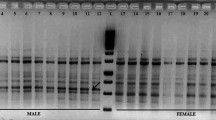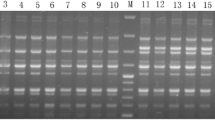Abstract
Sex type determination in papaya (Carica papaya L.) is very important for crop improvement processes because it accelerates the identification of the fruitful plants. The use of molecular technology provides a quick and reliable identification of sex types in plantlets growing in seedbeds. Random amplified polymorphic DNA (RAPD) markers were used to determine the sex types of Colombian cultivars of dioecious papaya genotypes. This species has three sex types (male, female and hermaphrodite) determined by a multiallelic locus. There are no morphological differences at the chromosome level; therefore the identification of sex types by chromosomal dimorphism is not possible. A RAPD marker of 900 bp was found in male plants, but not in females or hermaphrodites. From this RAPD marker a sequence characterized amplified region (SCAR) was developed and it was possible to amplify fragments from the genomes of male and hermaphrodite plants, but not the female ones. The results indicate that this new SCAR marker will be valuable to determine the sex type of papaya plants.



Similar content being viewed by others
References
Centro Internacional de la papa (CIP) (1998) Protocolos de Laboratorio de Biología Molecular. Tipificación Genética. In Ghislain M, Zhang D, Herrera MR (eds) Manual de Capacitación, 2nd edn. Departamento de Recursos Genéticos
Deputy JC, Ming R, Ma H, Liu Z, Fitch MM, Wang M, Manshardt R, Stiles JI (2002) Molecular markers for sex determination in papaya (Carica papaya L.). Theor Appl Genet 106:107–111
Gill G, Harvey C, Gardner R, Fraser L (1998) Development of sex-linked PCR markers for gender identification in Actinidia. Theor Appl Genet 97:439–445
Hormaza J, Dollo L, Polito V (1994) Identification of a RAPD marker linked to sex determination in Pistacia vera using bulk segregant analysis. Theor Appl Genet 89:9–13
Jiang CSK (1997) RAPD and SCAR markers linked to the sex expression locus M in asparagus. Euphytica 94:329–333
Hofmeyr JDJ (1938) Genetical studies of Carica papaya L. I. The inheritance and relation of sex and certain plant characteristics. II. Sex reversal and sex forms. South African Department of Agriculture and Science Bulletin, no. 187
Kim MS, Moore PH, Zee F, Fitch MM, Steiger DL, Manshardt RM, Paull RE, Drew RA, Seriota T, Ming R (2002) Genetic diversity of Carica papaya as revealed by AFLP markers. Genome 45:503–512
Lebel-Hardenack S, Grant S (1997) Genetics of sex determination in flowering plants. Trends Plant Sci 2:130–136
Lebel-Hardenack S, Hauser E, Law TF, Smith J, Grant SR (2002) Mapping of sex determination loci on the white campion (Silene latifolia) Y chromosome using amplified fragment length polymorphism. Genetics 160:717–725
Liu Z, Moore PH, Ma H, Ackerman CM, Ragiba M, Yu Q, Pearl HM, Kim MS, Charlton JW, Stiles JI, Zee FT, Paterson AH, Ming R (2004) A primitive Y chromosome in papaya marks incipient sex chromosome evolution. Nature 427:348–352
Ma H, Moore PH, Liu Z, Kim MS, Yu Q, Fitch MM, Sekiota T, Paterson AH, Ming R (2004) High-density linkage mapping revealed suppression of recombination at the sex determination locus in papaya. Genetics 166:419–436
Macedeo Lemos E, Lacerda C, Actis H (2002) Identification of sex in Carica papaya L. using RAPD markers. Euphytica 127:179–184
Mandolino G, Carboni A, Forapani S, Faeti V, Ranalli P (1999) Identification of DNA markers linked to the male sex in dioecious hemp (Cannabis sativa L.). Theor Appl Genet 98:86–92
Ming R, Moore P, Zee F, Ca A, Ma H, Paterson A (2001) Construction and characterization of a papaya BAC library as a foundation for molecular dissection of a tree-fruit genome. Theor Appl Genet 102:892–899
Paran I, Michelmore S (1997) Development of reliable PCR-based markers linked to downy mildew resistance genes in letucce. Theor Appl Genet 85:985–993
Parasnis A, Ramakrishna W, Chowdari K, Grupta V, Ranjekar P (1999) Microsatellite (GATA)n reveals sex-specific differences in Papaya. Theor Appl Genet 99:1047–1052
Polley A, Seigner E, Ganal M (1997) Identification of sex in hop (Humulus lupulus) using molecular markers. Genome 40:357–361
Sambrook J, Russell D (2001) Molecular cloning. A laboratory manual. 3rd edn. Cold Spring Habor Laboratory Press, Cold Spring Habor
Storey WB (1938) Segregation of sex types in Solo papaya and their application to the selection of seed. Am Soc Hort Sci Proc 35:83–85
Urasaki N, Tokumoto M, Tarora K, Ban Y, Kayano T, Tanaka H, Oku H, Chinen I, Terauchi R (2002) A male and hermaphrodite specific RAPD marker for papaya (Carica papaya L.). Theor Appl Genet 104:281–285
Van Droogenbroeck B, Breyne P, Goetghebeur P, Romeijn-Peeters E, Kyndt T, Gheysen G (2002) AFLP analysis of genetic relationships among papaya and its wild relatives (Caricaceae) from Ecuador. Theor Appl Genet 105:289–297
Williams JG, Kubelik AR, Livak KJ, Rafalski JA, Tingey SV (1990) DNA polymorphisms amplified by arbitrary primers are useful as genetic markers. Nucleic Acids Res 18:6531–6535
Wilton SD, Lim L, Dye D, Laing N (1997) Bandstab: a PCR-based alternative to cloning PCR products. Biotechniques 22:642–645
Acknowledgments
We thank Mauricio Pulido for technical suggestions. We also thanks to anonymous reviewers for valuable comments. This research was supported by Ministerio de Agricultura, Colombia.
Author information
Authors and Affiliations
Corresponding author
Rights and permissions
About this article
Cite this article
Chaves-Bedoya, G., Nuñez, V. A SCAR marker for the sex types determination in Colombian genotypes of Carica papaya . Euphytica 153, 215–220 (2007). https://doi.org/10.1007/s10681-006-9256-7
Received:
Accepted:
Published:
Issue Date:
DOI: https://doi.org/10.1007/s10681-006-9256-7




